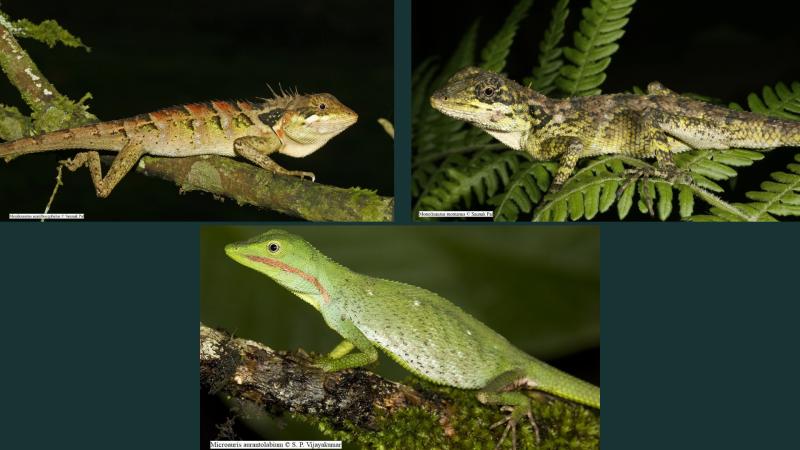
In the last few years, there has been a surge of new species discovered and described from the Western Ghats—one of the world's hottest biodiversity hotspot. For instance, so far in 2018, we have three new species of frogs and one snake from this region! Thanks to the systematic sampling of the landscape and modern molecular techniques, we are now starting to have a better picture of the richness of this ecosystem. In one such effort through four years of field work, scientists from the Indian Institute of Science, Bengaluru, Bombay Natural History Society (BNHS), Mumbai, Oklahoma State University, USA, and The Natural History Museum (NHM), London, have discovered two new species of lizards in the Western Ghats.
In the study, published in the journal Zootaxa, the researchers have used an integrative taxonomic approach that combines molecular analysis, geographical distribution and physical characteristics of the lizards. They have also reassessed the nomenclature of all the species of lizards of the genus Calotes found in the Western Ghats. The study was supported by the Critical Ecosystem Partnership Fund (Western Ghats), the Department of Biotechnology and the Ministry of Environment and Forests (MoEF).
The 27 known species of lizards of the genus Calotes, which includes the forest lizards and garden lizards, are spread across South and Southeast Asia and parts of China, with the Western Ghats in Peninsular India being a hotspot for several of them. This study splits Calotes into three genera while describing two new species.
“There has been no substantial taxonomic work on most of the agamid lizards from Peninsular India since they were initially described more than 150 years ago. Back then, taxonomy was only based on morphological observations of specimens with very less understanding of the ecology and biogeography of these groups. Hence, superficially similar-looking agamids were grouped together in the genus Calotes", remarks Mr. Saunak Pal from BNHS, who is the lead author of the study. "Now, with a widespread geographical study and use of molecular tools, we have a better understanding of the relationship of these lizards”, he adds.
Based on genetic and physical similarities and differences between the different species of lizards, the researchers of the study created an evolutionary tree—a branching diagram showing the evolutionary relationships among different species in the group. They found four evolutionary groups among agamid lizards of Peninsular India, two of which (Microauris and Monilesaurus) were earlier thought to be a part of the genus Calotes. They found that both of them were endemic to the Western Ghats and described them as new genera in this study.
The genus Microauris was named after the Latin word ‘auris’ meaning ear, referring to the extremely small tympanum these lizards have. The tympanum is an external hearing structure present in mammals, birds and some reptiles. At present, this genus has only one species, Microauris aurantolabium, which can be distinguished from other lizards as it has the smallest tympanum. The other genus, Monilesaurus, was named after the Latin word ‘monile’ meaning necklace, referring to the distinct neck fold found in the individuals of this genus, and the Greek word ‘sauros’ meaning lizard. Species belonging to this genus can be identified by the presence of a characteristic fold of skin on their neck.
The two new species discovered by the researchers belong to the genus Monilesaurus, and are named Monilesaurus acanthocephalus and Monilesaurus montanus. M. acanthocephalus are olive-red coloured lizards with a distinct long spine behind their eye, light brown head and, red and black blotches on their body. They are currently known from high elevation evergreen forests and along the forest-tea garden edges of the Megamalai hills of the southern Western Ghats.
The other species, M. montanus, named after the word ‘montane’, are restricted to the high elevation forests 1500m above the sea level, as their name suggests. These yellowish-green lizards have alternating light and dark brown patches on the back and are found in the high elevation evergreen forests of Kudremukh, Brahmagiri, Nilgiri and Elivalmalai.
The researchers believe that pre-monsoon might be a breeding season for this species. Both these species are diurnal in habit. “Nothing much is known about the behaviour of these new lizards other than that they are arboreal and have small distributional ranges restricted to the high elevations of the Western Ghats.”, says Mr. Pal.
While recent advancements in taxonomic tools and techniques have helped a systematic study on the evolutionary history and biogeography of many species, there is still a long way ahead for these lizards to be in the limelight. “While frogs of the Western Ghats are often in the news with the discovery of many new species, reptiles have received less attention. There is, however, a substantial diversity of lizards and snakes in the Western Ghats as well”, remarks Mr. Pal, talking about what could still be unexplored in the forests.
The researchers believe there is a host of exciting things the lizards can bring to the board. “This study signifies the lack of understanding of the evolutionary relationships among Indian reptiles and shows that we still need a lot more systematic research on Indian agamids, especially for the widespread but ignored groups like the Rock Agamas and those occurring in the North East. Along with morphology, we also need to study the distribution and molecular phylogenies to understand the relationship and evolution of lizards”, signs off Dr. Deepak, a co-author of this study from NHM.
Editor's note: Image was changed as the previous one had wrong identification. We regret this error.






